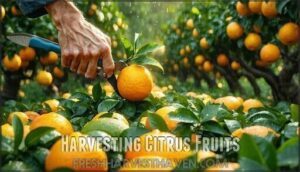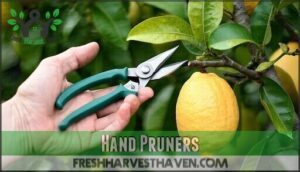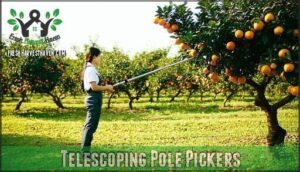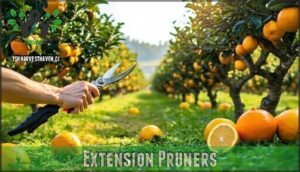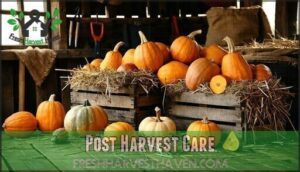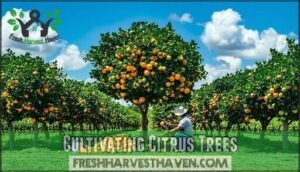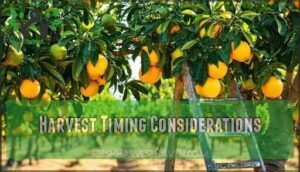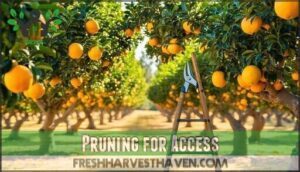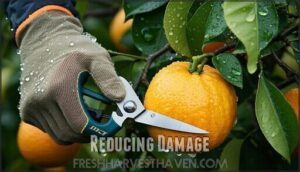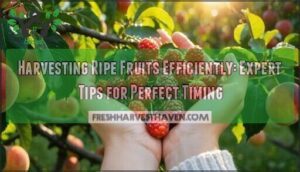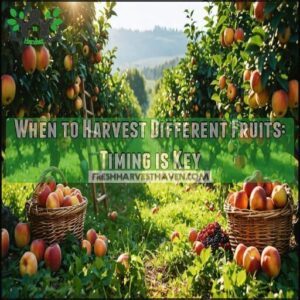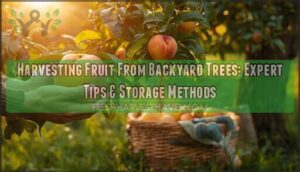This site is supported by our readers. We may earn a commission, at no cost to you, if you purchase through links.
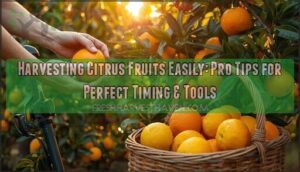
Grab hand pruners for low fruit, or try a pole picker for the high ones (think reaching for the last cookie on the shelf). Twist and snip gently, treating each orange or lemon with care to avoid bruises.
Sharp, clean tools make the whole job smoother. Remember, citrus doesn’t ripen after picking, so patience truly pays off.
Store your haul cool and dry, and you’ll enjoy juicy rewards. There’s more to this craft than meets the eye.
Table Of Contents
- Key Takeaways
- Harvesting Citrus Fruits
- Choosing Harvest Tools
- Post Harvest Care
- Cultivating Citrus Trees
- Harvest Timing Considerations
- Easy Harvesting Methods
- Frequently Asked Questions (FAQs)
- How is citrus fruit harvested?
- How do I know when my citrus fruit is ready to pick?
- Will oranges ripen if you pick them early?
- How to harvest citrus fruit?
- Should you pick all the fruit off citrus trees?
- What is the easiest citrus fruit to grow?
- What is the best way to propagate citrus?
- How to harvest citrus fruits?
- What is the best time of day to pick citrus fruit?
- How do you pick good citrus fruits?
- Conclusion
Key Takeaways
- Pick citrus only when it’s fully colored, firm, and sweet—don’t rely on it ripening off the tree.
- Use sharp, clean pruners or a pole picker to snip fruit gently and avoid bruises.
- Always harvest in the cool morning and handle fruit with care—no rough yanking or stacking.
- Store your haul in a cool, dry spot and keep different varieties separated for longer-lasting freshness.
Harvesting Citrus Fruits
You’ll find that harvesting citrus at the right moment makes all the difference between sweet success and sour disappointment.
Harvest citrus at just the right time for juicy perfection—too soon or too late brings only bitter results
The key lies in mastering proper timing, recognizing ripeness cues, and using techniques that protect both your fruit and your trees, which is crucial for achieving sour disappointment is not the goal, but rather avoiding it.
Optimal Harvest Time
Mastering perfect harvesting time reveals citrus yield potential and fruit ripeness perfection. Understanding seasonal timing and harvest readiness transforms your crop maturity success—you’ll never guess wrong again.
Key harvest scheduling principles:
- Winter citrus: Oranges and grapefruits reach peak harvest from December through May
- Year-round varieties: Lemons and limes offer continuous harvest readiness due to ongoing flowering cycles
- Weather monitoring: Early gathering prevents frost damage that destroys flavor and texture
- Regular picking: Consistent citrus harvesting maintains tree productivity and prevents overripe fruit from attracting pests
Since citrus doesn’t ripen after picking, patience pays off. Wait for complete crop maturity—your taste buds will thank you later.
Ripeness Indicators
Once you know it’s the right season, use these ripeness indicators before picking.
Citrus harvesting is part art, part science.
Look for:
- Color change—no green left.
- Fruit texture—firm, not rock-hard or mushy.
- Sugar content—taste for that sweet spot.
- Skin thickness—it should feel even, not bumpy.
- Acid levels—balanced tang, not mouth-puckering, to achieve the perfect balance.
Harvesting Techniques
Through proper citrus harvesting techniques, you’ll protect both your trees and precious fruit. Sharp pruning tools make clean cuts that heal faster than torn branches.
Sharp tools and gentle hands turn every citrus harvest into a sweet success for both fruit and tree
Here’s your harvest efficiency roadmap:
- Choose the right harvest tools – hand pruners for close fruit, telescoping pole pickers for high branches
- Master gentle fruit handling – twist and clip rather than yank to prevent bruising
- Practice smart picking techniques – cut stems cleanly while sanitizing tools between trees
Choosing Harvest Tools
You’ll need the right tools to harvest citrus efficiently without damaging your trees or fruit.
The three essential categories are hand pruners for close work, telescoping pole pickers for reaching high branches, and extension pruners that combine cutting power with extended reach.
Hand Pruners
Your hand pruner becomes your trusted sidekick for harvesting citrus—think of it as the Swiss Army knife of fruit picking. Choose ergonomic pruning shears with comfortable Handle Ergonomics that won’t leave your hands cramping after an hour of fruit harvesting.
Sharp bypass blades work best for harvesting citrus, making clean cuts through stems without crushing delicate fruit. Anvil-style pruners can bruise soft citrus, so stick with bypass designs for Fruit Clipping precision.
Pruner Safety starts with keeping blades sharp—dull tools require more force and increase injury risk. Tool Maintenance means cleaning sap buildup and oiling pivot points regularly.
Pruning Techniques for fruit picking involve cutting stems close to branches, leaving small stubs. This prevents bark damage and disease entry points.
When selecting the right tool, consider investing in Ergonomic Pruning to reduce fatigue and improve overall harvesting efficiency.
Pruner Size Matters!
Telescoping Pole Pickers
Telescoping pole pickers transform your citrus harvesting experience, reaching those stubborn fruits without risky ladder climbing.
Safe harvesting means reaching high without the risk—your citrus stays perfect, and so do you.
These versatile harvesting tools make easy harvest possible for trees up to 18 feet tall.
Choose your telescoping pole picker wisely:
- Fiberglass extension handles beat wood—they’re lighter and won’t splinter during intense picking sessions
- Replaceable fruit picker heads let you switch between basket and clipper styles for different citrus types
- Pole material matters—aluminum offers durability while fiberglass provides comfort during extended use
- Safety features like rounded basket edges prevent accidental fruit puncturing
- Picker safety includes secure locking mechanisms preventing unexpected pole collapse
When selecting a telescoping pole picker, consider the picker product options to guarantee you find the best tool for your needs.
These pole picker tips guarantee efficient citrus harvesting while protecting both you and your precious fruit.
Extension Pruners
While pole pickers handle distant fruit, extension pruners give you surgical precision for orange harvesting, lemon harvesting, and grapefruit harvesting.
These harvesting tools extend up to 20 feet, letting you clip fruit exactly where needed.
| Feature | Benefit | Best For |
|---|---|---|
| Clip & Hold Action | Prevents fruit from falling | Delicate citrus varieties |
| 20-Foot Reach | Eliminates ladder use | Tall mature trees |
| Precision Control | Clean, targeted cuts | Selective harvesting |
Pruning Techniques matter here—make clean cuts leaving small stems attached.
Fruit Clippers with bypass action work best for thick-stemmed varieties.
Tool Maintenance keeps blades sharp for efficient cuts.
When selecting the right equipment, consider using pruning tool sets to enhance your harvesting experience.
Pruner Safety means never overextending your reach.
These tools boost Harvest Efficiency by combining the reach of poles with the control of hand pruners.
Post Harvest Care
Once you’ve picked your citrus, proper care determines how long you’ll enjoy the fruits of your labor.
The right storage conditions and gentle handling can stretch your harvest from days to weeks of fresh, flavorful citrus.
Storage Conditions
Once you’ve picked your citrus, smart citrus fruit storage becomes your next victory.
Cool Storage at 41-50°F keeps fruit fresh while Humid Control (85-95%) prevents shriveling.
Here’s your storage playbook:
- Storage Temperature: Maintain 7-10°C to maximize Shelf Life and reduce decay
- Fruit Packaging: Use breathable containers for proper airflow
- Humidity monitoring: Keep levels steady to prevent mold or drying
- Separation strategy: Avoid ethylene-producing fruits for better fruit preservation
These storage requirements guarantee your longterm storage success.
Understanding proper storage temperature control is vital for maintaining ideal conditions.
Handling Precautions
Proper handling protects your citrus investment from fruit damage. Gentle handling prevents fruit bruising and maintains quality during harvest and transport.
| Handling Stage | Best Practice | Damage Control |
|---|---|---|
| Picking | Cradle each fruit | Avoid pulling force |
| Transport | Use shallow containers | Prevent stacking pressure |
| Storage | Handle minimally | Keep soft skin care priority |
| Cleaning | Pat dry gently | No rough scrubbing |
Always sanitize tools between trees for harvest safety. Your bruise prevention efforts start the moment you touch the fruit—think of citrus as nature’s delicate artwork requiring careful fruit handling.
Shelf Life Factors
Beyond proper fruit handling during harvest, smart storage conditions can double your citrus shelf life.
Temperature management between 40-50°F paired with humidity control around 85% creates the perfect environment for postharvest care.
- Control storage temperature at 40-50°F for ideal preservation
- Maintain humidity levels around 85% to prevent shriveling
- Use breathable containers to avoid moisture buildup and mold
- Separate from ethylene producers like bananas and apples
- Sort by variety since different citrus types have varying storage needs.
Ethylene effects can cut your fruit storage time in half, so keep those citrus away from gas-producing fruits.
Cultivating Citrus Trees
Proper cultivation sets the foundation for easier harvests and healthier trees that produce better fruit year after year.
You’ll want to focus on three key areas: grafting for stronger trees, consistent watering practices, and smart fertilizer application that matches your soil’s needs.
Grafting Benefits
Success in citrus grafting transforms ordinary trees into powerhouse producers.
You’ll gain improved yields, disease resistance, and increased hardiness by combining robust rootstock with premium scions.
This technique delivers better roots that anchor your trees while enhancing flavor profiles substantially.
| Grafting Benefit | Result | Timeline |
|---|---|---|
| Improved Yields | 2-3x more fruit | 2-3 years |
| Disease Resistance | Fewer infections | Immediate |
| Enhanced Flavor | Premium taste | First harvest |
| Increased Hardiness | Weather tolerance | Year one |
Professional citrus farming relies on grafting benefits for consistent fruit quality and reliable harvests that weather seasonal challenges.
Water Control
Water control frequently determines whether your citrus fruits will be flavorful gems or disappointing duds.
Smart irrigation systems like drip irrigation deliver targeted hydration while preventing wasteful runoff. Consistent soil moisture reduces fruit drop by up to 40% during dry spells, making your investment worthwhile.
Monitor water tables and implement proper drainage methods to avoid waterlogged roots that spell disaster for citrus farming success. Container trees need well-draining potting mix to thrive.
Drip irrigation boasts exceptional efficiency.
- Install drip irrigation for precise water delivery
- Check soil moisture weekly with tensiometers
- Create raised beds for improved drainage methods
- Apply mulch to retain moisture naturally
- Schedule deep watering to encourage strong root systems
Fertilizer Application
Your citrus crop deserves fertilizer that matches its unique nutrient needs.
Soil testing reveals hidden deficiency symptoms before they hurt your harvest. Time application timing right—feed before flowering for maximum impact.
Choose organic options or traditional citrus fertilizer based on your tree’s signals.
| Nutrient | Signs You Need It |
|---|---|
| Nitrogen | Yellow, dropping leaves |
| Phosphorus | Poor flowering, weak roots |
| Potassium | Brown leaf edges, small fruit |
| Iron | New leaves turn yellow first |
Smart nutrient management transforms struggling trees into citrus fruits powerhouses.
Harvest Timing Considerations
Weather conditions and plant health substantially impact your citrus harvest timing, so you’ll need to stay flexible with your schedule.
Frost threatens ripe fruit quality, while diseases like citrus canker spread faster during wet conditions, making early harvest your best defense against crop loss.
Weather Impact
Weather patterns can make or break your citrus harvest success. Temperature Effects become critical when temperatures drop below 30°F—Frost Damage destroys fruit overnight, causing up to 35% crop loss.
Rainfall Influence doubles fungal infections and fruit splitting, while high humidity above 80% shortens shelf life by nearly a week. Sunlight Exposure above 90°F increases skin damage during harvesting. Seasonal Variations require constant monitoring since conditions change rapidly.
Here’s your weather-smart harvesting strategy:
- Harvest 24 hours after rainfall to prevent bruising and mold issues
- Check forecasts daily—freeze warnings mean emergency harvest mode
- Choose morning hours when humidity stays between 50-65% for best results
Smart timing protects your investment and guarantees citrus easy harvesting with minimal citrus fruit damage.
Disease Control
While healthy trees resist most threats, disease prevention starts with vigilant monitoring. You’ll spot trouble early through regular checks—yellowing leaves, unusual spots, or wilting branches signal problems ahead.
| Disease Type | Prevention Method | Action Timeline |
|---|---|---|
| Fungal Issues | Organic sprays, pruning | Monthly application |
| Root Problems | Soil testing, drainage | Seasonal assessment |
| Pest Damage | IPM strategies, monitoring | Weekly inspections |
Smart citrus disease control combines organic sprays with proper tree maintenance. Clear debris around trunks, prune low branches for airflow, and address nutrient needs through soil testing. Understanding the disease triangle explained is essential for effective management. Monthly pest control checks catch issues before they spread, protecting your harvest investment.
Easy Harvesting Methods
You can make citrus harvesting much easier by strategically pruning your trees and using proper handling techniques.
The right approach saves time, reduces strain on both you and the tree, and keeps your fruit in perfect condition from branch to storage.
Pruning for Access
Smart citrus pruning techniques transform harvesting from a wrestling match into a breeze. You’ll want to keep tree height manageable and focus on strategic branch removal for better sunlight exposure.
Sharp tools are essential for clean cuts, and for more information, you can visit Sharp tools.
- Maintain ladder safety by keeping trees under 15 feet tall
- Open dense canopies through regular branch removal for improved sunlight exposure
- Schedule pruning frequency annually to prevent overcrowding and maintain easy access
Fruit Handling
Why fumble with your precious citrus when Gentle Placement guarantees perfect fruit?
Use padded containers for Bruising Prevention and handle each piece like treasure.
Never stack citrus beyond two layers—Stacking Limits matter for Fruit Freshness Preservation.
Variety Separation prevents flavor mixing.
Your Citrus Fruit Delicate Handling skills will keep every orange and lemon flawless.
Reducing Damage
Master citrus harvesting damage prevention by prioritizing gentle handling and smart techniques.
- Clean cuts with sharp tools – Dull blades increase rind scarring by 40% and create fungal entry points
- Use padded containers – Cushioned harvest bags reduce bruising in soft varieties by 22%
- Avoid wet conditions – Harvesting after rainfall triples skin abrasion risk and boosts rot cases 21%
- Transport quickly – Moving fruit within two hours prevents pitting and compression blemishes
Tool maintenance and proper storage keep your citrus pristine from tree to table.
Frequently Asked Questions (FAQs)
How is citrus fruit harvested?
Think of gathering citrus as a treasure hunt—look for brightly colored, firm fruit.
Snip or twist each one free, leaving a short stem, and handle gently to dodge bruises.
Sharp pruners make life much easier!
How do I know when my citrus fruit is ready to pick?
If your citrus is deeply colored, feels firm but not rock-hard, and a gentle twist pops it off the stem, you’re golden.
Taste one—if it’s juicy and sweet, don’t leave it hanging like forgotten socks!
Will oranges ripen if you pick them early?
No, oranges won’t ripen after you pick them early.
Unlike bananas or tomatoes, citrus fruits stop developing once removed from the tree.
You’ll end up with sour, underdeveloped fruit that never reaches its sweet potential.
How to harvest citrus fruit?
Snip ripe fruit with sharp pruning shears, leaving a short stem.
Don’t yank—treat them like fragile treasures!
Gently place them in a basket, and avoid stacking to keep your juicy haul bruise-free and beautiful.
Should you pick all the fruit off citrus trees?
No need to clear the tree like it’s a fall cleaning spree—leave some ripe fruit for staggered picking.
This lets you enjoy fresh flavor longer, prevents waste, and keeps pests from moving in too soon.
What is the easiest citrus fruit to grow?
If you like things simple, lemons are your low-maintenance champs.
They thrive in pots or the ground, forgive you if you forget water now and then, and reward you with fruit nearly all year.
Easy, breezy, lemon squeezy!
What is the best way to propagate citrus?
Did you know grafted citrus trees bear fruit up to three years faster?
For best results, graft healthy budwood onto sturdy rootstock.
It’s much easier than sprouting seeds, and you’ll skip the “wait forever” stage!
How to harvest citrus fruits?
Cut citrus fruits from the tree with sharp pruners so you leave a stub of stem on each fruit.
Handle them gently.
If you pull too hard, you’ll bruise your haul and, honestly, nobody wants sad oranges.
What is the best time of day to pick citrus fruit?
Strike while the iron’s hot and pick citrus in the cool morning.
You’ll dodge afternoon heat, keep fruit fresh, and avoid sunburn.
It’s smoother work, less sweat, and your haul stays plump and perky.
How do you pick good citrus fruits?
Look for citrus fruits that feel heavy for their size, have bright, even color, and give slightly when squeezed.
Skip any with soft spots or fades.
If it smells fresh and citrusy, you’ve struck gold!
Conclusion
Picture Jane, who once bruised every orange but now nails harvesting citrus fruits easily just by watching color and wielding tools like a pro.
When you wait for just the right shade, snip with care, and stash your haul smartly, you’ll see—and taste—the difference.
Don’t rush; patience, sharp pruners, and gentle hands go a long way.
So go ahead, pick your citrus with confidence and enjoy a juicy reward for mastering these easy, practical tips.
- https://www.thesill.com/blogs/outdoor-plant-care/citrus-trees-101-harvesting?srsltid=AfmBOorwwk4ozfdej9j7AvJTx18hsDJUHGaL47764GwHU_TXNZxZIdsu
- https://www.villageharvest.org/resources/ladder-less-fruit-harvesting-techniques
- https://www.starkbros.com/growing-guide/how-to-grow/fruit-trees/citrus-trees/harvesting?srsltid=AfmBOopq5hlq3SQcjgSC_Sklv3QQpoW1sIoPIQx5yOYba9RFi9YLqiBa
- https://www.yarden.com/citrus-tree-care/harvesting/?srsltid=AfmBOoo5_XD6VJ0jK7xnahXAlnibMRuelz0iMFUW8Ki2nu4b1qcGR2zF
- https://manzana-nules.com/good-practices-in-citrus-harvesting/

